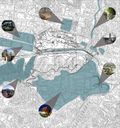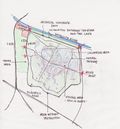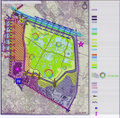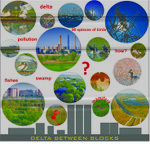Planting Design 2013 Working Group 24 - Case Study B
---> back to group page working group 24
Please add the title of your case study here, adjust the map coordinates and replace the moa image with a characteristic image of your site
| Name | Vacaresti Lake | |
| Location | Bucharest | |
| Country | Romania | |
| Authors | Irina Slobozeanu | |
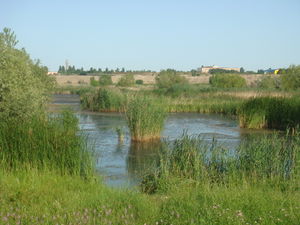
| ||
|
| ||
Rationale: Why is this case interesting?
Please give a short introduction to the site you have selected (not more than 150 words)
The "Vacaresti Lake" with a 190 ha surface, is situated in south-east of Bucharest, almost 5 km far away from the city center. It is an artificial lake with a very interesting history, which in the past the entire place was on the government attention and now after over 20 years it's is only a neglected space with an incredible ecosystem looking like a delta with a specific fauna and flora. Here are a lot of different areas of willow, small ponds, swamplands, concrete, delta, mud, trees and other Natura 2000 species of plants, European protected spices of animals, like red duck, white hen, turtles, amphibians, reptiles (snakes, different species of lizards), over 90 species of birds of which 40 of them are protected and of course various speeches of fishes. Marshes are rich in insects, earthworms, leeches, mollusks. Unfortunately, real estate development included proximity of this delta areas creating an incompatibility with this type of habitat.
- Why did you select it?
I choose this site because of it's structure, evolution and particularity that no other lake from Bucharest and from many countries has and I think it is representative as a case study, as an area with a cultural meaning, with such an ecosystem in the middle of city which preserves beauty. The existence of such an ecosystem in a city seems a contradiction, but they continue to exist.
- Is it exemplary for a specific theme or a problem?
This lake it is exemplary for many reasons because it has an incredible potential for being part of our environment. The site it is surrounded by a dike that protects the flora and fauna of auditory and noxious pollution generated by city traffic. Bucharest is now below 7 square meter/person, not 26, as European regulations provide, while the World Health Organization recommends 50. If this land would become an urban reserve, Bucharest would win every square meter of the wild.
- In how far does it relate to your life?
Discovering this place made me think that the city may have a different evolution and also this area should be valued as much as it deserved by minimal interventions and more protection.
Author's perspective
From which professional background/perspective are your documenting this case?
As a urban planner and landscape architect I found a real problem regarding the fight between green spaces and real estate development, loss and neglect landscape in favor of concrete and brick tissue. The past 25 years the city of Bucharest has changed a lot and built area increased considerably, affecting most green areas or creating a contrast between the new buildings and green spaces, areas that keep them culture, tradition and higher lifestyle. This case study was also one of my projects and it was interesting to me to see that this place has attracted attention of National Geographic Team, caught them and place value in the eyes of people. It is a place that only requires protective society involvement, and specialists to capitalize on potential elements and reduce the dysfunction of this area. And on my opinion it is one of the places that really deserves attention and fits perfectly with what we were discussing at the seminar, being such a representative example of the city.
Landscape and/or urban context of your case
- Biogeography, cultural features, overall character, history and dynamics
This aria dates back from XVIII century, when it was out of the city. Here on this land before they built the monastery this was agricultural land. After a couple of years when the communist regime of Ceausescu came, they decided to demolish the building in favour of an artificial lake. When he died everything was abandoned including this area. This place during those 25- 30 years has chanced a lot from function, culture, development, landscape and also vegetation. So, what was a decade ago a simple commuter community of collective housing blocks, constructed mainly during the communist regime, now is in the eve of transformation. The real estate market threatens the fragile equilibrium that still prevails in the zone. Now this place is used only for fishing or just for walking waiting the beautiful sunset.
- Illustration: Map; sketches; short descriptive analyses
Analytical drawings
- widths="150px"
Please add four analytical sketches/drawings (or montages/schemes) of your case and take the following aspects into account:
- natural dynamic versus cultural framework - in how far do these two forces come together in your case?
- dynamic through the year (you may imagine how the site looks in spring and summer, maybe you also remember it)
- highlight potentials and problems
Projective drawings
- Please add four projective sketches/drawings (or montages/schemes) for your case and take the following aspects into account:
- How would you like this case to change in the near future? (in 1-2 years)
- And how could it look like in 10-15 years?
- Projective Drawings
- Yourfilename4.jpg
projective drawing 4
Summary and conclusion
Please summarize your case and give arguments for your projective design (approx 150 words).
Image Gallery
You may add a series of images/photos in addition to the sketches/drawings
- Image Gallery
- Yourfilename4.jpg
image 4
References
* Please make sure that you give proper references of all external resources used.
* Do not use images of which you do not hold the copyright.
* Please add internet links to other resources if necessary.
About categories: You can add more categories with this tag: "", add your categories

